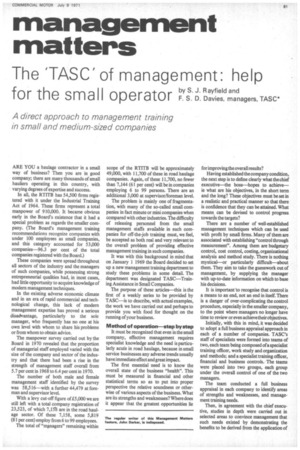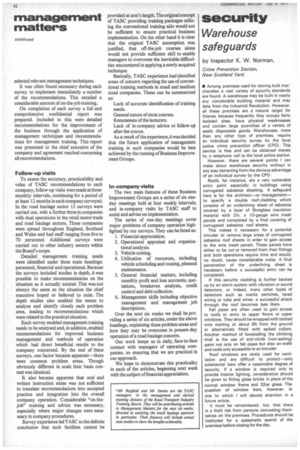management matters
Page 83

Page 84

If you've noticed an error in this article please click here to report it so we can fix it.
The "TASC" of management: help
for the small operator 'D■ RDa:vfliPcirannadn y. . ..._..agers, TASC*
A direct approach to management training in small and medium-sized companies
ARE YOU a haulage contractor in a small way of business? Then you are in good company, there are many thousands of small hauliers operating in this country, with varying degrees of expertise and success.
In all, the RTITB has 54,500 firms registered with it under the Industrial Training Act of 1964. These firms represent a total manpower of 910,000. It became obvious early in the Board's existence that it had a special problem as regards the smaller company. (The Board's management training recommendations recognize companies with under 100 employees as small companies, and this category accounted for 53,000 companies-96.3 per cent of the total companies registered with the Board.) These companies were spread throughout all sectors of the industry and the managers of such companies, while possessing strong entrepreneurial qualities had, in most cases, had little opportunity to acquire knowledge of modern management techniques.
In the existing adverse economic climate and in an era of rapid commercial and technological change, this lack of modern management expertise has proved a serious disadvantage, particularly to the sole manager, who frequently has no one at his own level with whom to share his problems or from whom to obtain advice.
The manpower survey carried out by the Board in 1970 revealed that the proportion of managerial staff employed varied with the size of the company and sector of the industry and that there had been a rise in the strength of management staff overall from 5.7 per cent in 1968 to 6.4 per cent in 1970.
The number of both male and female management staff identified by the survey was 58,516—with a further 44,479 at foreman and supervisor level.
With a levy cut-off figure of £5,000 we are still left with a total company registration of 23,523, of which 7,1*5.8 are in the road haulage sector. Of these 7,158, some 5,819 (81 per cent) employ from 6 to 99 employees.
The total of "mpagers" remaining within
scope of the RTITB will be approximately 49,000, with 11,700 of these in road haulage companies. Again, of these 11,700, no fewer than 7,144 (61 per cent) will be in companies employing 6 to 99 persons. There are an additional 3,000 at supervisor/foreman level
The problem is mainly one of fragmentation, with many of the so-called small companies in fact minute or mini companies when compared with other industries. The difficulty of releasing personnel from the small management staffs available in such companies for off-the-job training must, we feel, be accepted as both real and very relevant to the overall problem of providing effective management training in such companies.
It was with this background in mind that on January 1 1969 the Board decided to set up a new management training department to study these problems in some detail. The department was designated TASC—Training Assistance in Small Companies.
The purpose of these articles—this is the first of a weekly series to be provided by TASC—is to describe, with actual examples, the work we have carried out and perhaps to provide you with food for thought on the running of your business.
Method of operation—step by step
It must be recognized that even in the small company, effective management requires specialist knowledge and the need is particularly acute in road haulage, because in small service businesses any adverse trends usually have immediate effect and great impact.
The first essential need is to know the overall state of the business "health". This must be measured in financial and other statistical terms so as to put into proper perspective the relative soundness or otherwise of various aspects of the business. What are its strengths and weaknesses? Where does it appear that the greatest opportunities lie
for improving the overall results?
Having established the company condition, the next step is to define clearly what the chief executive—the boss—hopes to achieveie what are his objectives, in the short term and the long? These objectives must be set in a realistic and practical manner so that there is confidence that they can be attained. What means. can be devised to control progress towards the targets?
There are a number of well-established management techniques which can be used with profit by small firms. Many of them are associated with establishing "control through measurement". Among them are budgetary control, cost control, costing, organizational analysis and method study. There is nothing mystical—or particularly difficult—about them. They aim to take the guesswork out of management, by supplying the manager with up-to-date information on which to base his decisions.
It is important to recognise that control is a means to an end, not an end in itself. There is a danger of over-complicating the control procedure, especially in the smaller company, to the point where managers no longer have time to review or even achieve their objectives.
Initially, with this in mind, it was decided to adopt a full business appraisal approach in each of a number of companies. TASC's staff of specialists were formed into teams of two, each team being composed of a specialist training officer, work study and organization and methods; and a specialist training officer, financial and business controls. The teams were placed into two groups, each group under the overall control of one of the two managers.
The team conducted a full business appraisal in each company to identify areas of strengths and weaknesses, and management training needs.
Then, in agreement with the chief executive, studies in depth were carried out in selected areas to convince management that such needs existed by demonstrating the benefits to be derived from the application of selected relevant management techniques.
It was often found necessary during each survey to implement immediately a number of the recommendations. This entailed a considerable amount of on-the-job training.
On completion of each survey a full and comprehensive confidential report was prepared. Included in this were detailed recommendations for the improvement of the business through the application of management techniques and recommendations for management training. This report was presented to the chief executive of the company and agreement reached concerning all recommendations.
Follow-up visits
To assess the accuracy, practicability and value of TASC recommendations to each company, follow-up visits were made at threemonthly intervals, continuing for a period of at least 12 months in each company surveyed. In the road haulage sector 13 surveys were carried out, with a further three in companies with dual operations in the retail motor trade and road haulage sectors. These companies were spread throughout England, Scotland and Wales and had staff ranging from five to 70 personnel. Additional surveys were carried out in other industry sectors within the Boatd's scope.
Detailed management training needs were identified under three main headings: personnel, financial and operational. Because the surveys included 'studies in depth, it was possible to make recommendations on the situation as it actually existed. This was not always the same as the situation the chief executive hoped or believed to exist. The depth studies also enabled the teams to analyse and identify closely each problem area, leading to recommendations which were related to the practical situation.
Each survey enabled management training needs to be analysed and, in addition, enabled recommendations for improved business management and methods of operation which had direct beneficial results to the company concerned. By the end of these surveys, one factor became apparent—there were common problem areas. Though obviously different in scale their basic content was identical.
It also became apparent that oral and written instruction alone was not sufficient to translate recommendations into accepted practice and integration into the overall company operation. Considerable "on-thejob" training and advice was necessary, especially where major changes were necessary in company procedures.
Survey experience led TASC to the definite conclusion that such facilities cannot be provided at arm's length. The original concept of TASC providing training packages utilizing the conventional training aids would not be sufficient to ensure practical business implementation. On the other hand it is clear that the original TASC assumption was justified, that off-the-job courses alone would not provide sufficient skill to enable managers to overcome the inevitable difficulties encountered in applying a newly acquired technique.
Basically, TASC experience had identified areas of concern regarding the use of conventional training methods in small and medium sized companies. These can be summarized as: Lack of accurate identification of training needs.
General nature of most courses.
Remoteness of the lecturers.
Lack of in-company advice or follow-up after the course.
As a result of the experience, it was decided that the future application of management training in such companies would be best achieved by the running of Business Improvement Groups.
In-company visits
The two main features of these Business Improvement Groups arc a series of six oneday meetings held at four weekly intervals; and in-company visits by TASC staff to assist and advise on implementation.
The series of one-day meetings cover major problems of company operation highlighted by our surveys. They can be listed as: 1. Financial appreciation.
2. Operational appraisal and organisational analysis.
3. Vehicle costing.
4. Utilization of resources, including vehicle scheduling and routing, planned maintenance.
5. General financial matters, including monthly profit and loss accounts, quotations, breakeven analysis, credit control and debt collection.
6. Management skills including objective management and management job descriptions.
Over the next six weeks we shall be providing a series of six articles, under the above headings, explaining these problem areas and how they may be overcome in present-day operation of a road haulage concern.
Our work keeps us in daily, face-to-face contact with managers of operating companies, so ensuring that we are practical in our approach.
We hope to demonstrate this practicality in each of the articles, beginning next week with the subject of financial appreciation.












































































































































